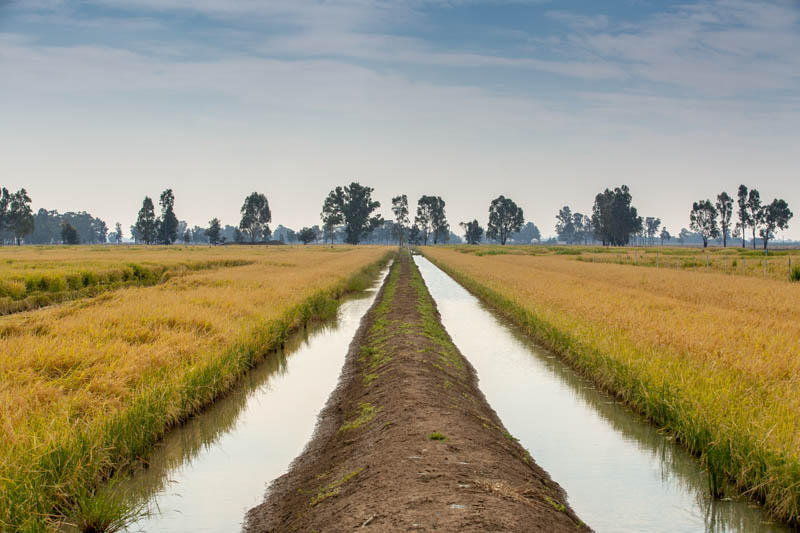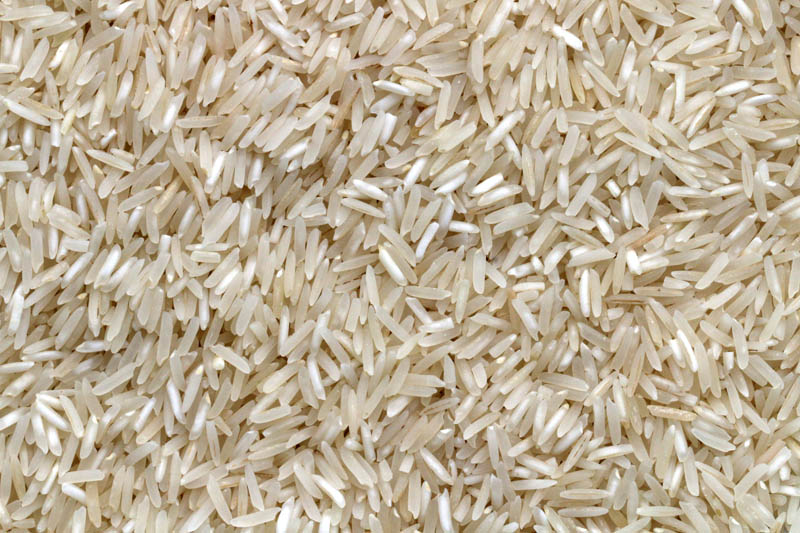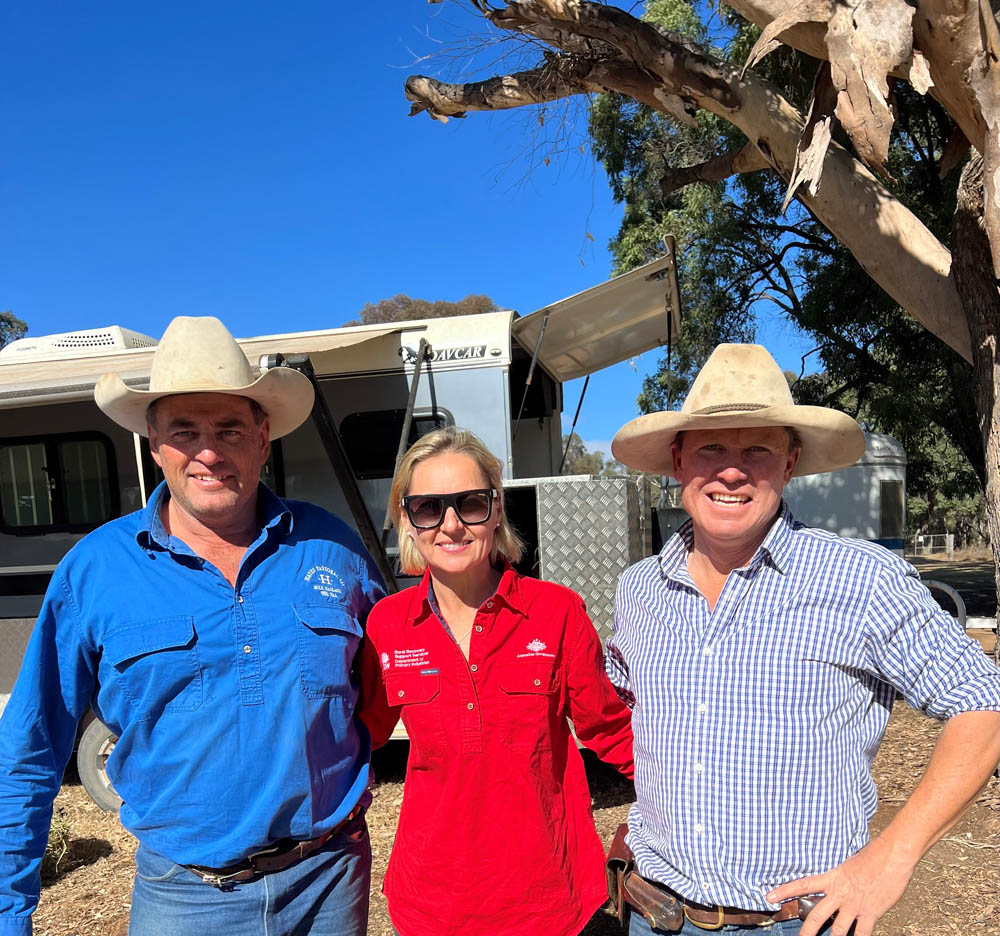The challenging production conditions were not mirrored in crop pricing, as international factors helped to lend support to export marketing arrangements and in turn paddy pool prices reached a new record level of $461/tonne for the Riverina-Murray region. 203 The key driver behind these record prices was ongoing drought conditions experienced in California which severely restricted production with prices increasing sharply, and as a result Australian prices also increased due to the direct export competition between the two locations. The result of these factors is that rice GVP is estimated to decline modestly to $219 million.
- GVP $219 million est. Down 20% year-on-year.
- Strong international and domestic prices.
- Export demand was strong, reaching $394 million.


Production
Rice Production and Southern Water Allocations 1 187 188 m
- Murrumbidgee-Murray GS Water Allocations (RHS)
- Rice Production (kt)
The season also delivered cooler than average conditions, particularly over the key growing period of January and February, with average overnight lows at Yanco being 1.2 degrees Celsius lower in January (with a minimum of 10.1 degrees) and 2.6 degrees lower in February (with a minimum of 8.4 degrees) than the long term averages for these months respectively. 194 These low temperatures came over the critical panicle initiation period of rice development, where temperatures below 17 degrees Celsius can disrupt plant reproductive growth, and as a result average yields declined modestly. Consequently, and despite the near maximum water allocations for the Murray and Murrumbidgee, the above factors combined to reduce the overall rice production by 25% year on year to an expected 515 thousand tonnes and just marginally higher than the long term average production levels. 1
Price and Macroeconomic Conditions
Global rice production is estimated to have remained relatively steady year on year at near record levels of 513 million tonnes in 2022-23. 124 In contrast, there have been significant production constraints of short and medium grain varieties from Australia’s key export competitor of California, with short-medium grain rice production falling 31% year on year, and 41% down on the 10 year moving average. 204 The cause of the decline has been compounding and intense drought conditions in California over multiple seasons, and as a result of the supply shortages, farm gate prices for Californian short-medium grain have risen 59% in just two years and mirrored in Californian export prices. 204 The significant supply shortage has likely lent support to both Australian export prices and farm gate returns which compete with Californian rice in export markets.
International Rice Prices 35 121 q
- Thailand, 5% Broken - Long Grain
- US No. 2, 4% Broken - Long Grain
- US California Medium Grain (FOB mill)
- Australian Rice Export Price (Cost & Freight)
Trade
Australian International Rice Trade 35
- Export value
- Import value
- Export Average Value
- Import Average Value
Offsetting Australia’s predominantly short-medium grain rice export trade was 221 thousand tonnes of imports, most of which is made up of long grain and specialty rice varieties such as Basmati, Jasmine and other specialty rice varieties. 35 Imports were down a marginal 2.3% year on year in volume terms, most likely due to the increased supply domestically which may have displaced some internationally sourced rice. 35 The top three origins of these imports were Thailand, India and Vietnam respectively, which have been consistent suppliers to Australia over the last 3 years.
Outlook
Based on the current level of water allocations for the coming season and the prospect of drier conditions at sowing, which should enable improved field preparation and planting activities, the current forecast is for rice production to increase by 26% year on year to 650 thousand tonnes, and just shy of the levels two years prior. 1
Internationally, production of short-medium grain rice varieties in California are forecast to make a sharp recovery in 2023-24 with production tipped to increase by 76%, as El-Nino conditions are expected to bring more conducive rice growing conditions to California. 205 Markets are factoring in higher supply of short-medium grain rice from California, with prices beginning to decline from their record high levels. 121 Australian rice prices are likely to be pressured by the increase in supply from their key competitor region, with ample supply also anticipated from Australia for the current marketing year.
Offsetting the direct pressure from California, prices are likely to receive indirect support from India’s announcement that it was banning exports of non-basmati white rice in an effort to curb rising domestic inflation, potential El-Nino induced supply shortages and forthcoming Indian elections. 3 Given India has been the largest exporter of white rice for many years, exporting approximately 39% of global rice exports over the past 3 years, the export ban has driven spot markets up sharply. 124 While India is not a direct competitor with Australian rice exports in most markets, the significant gap in international supply is expected to lend support to Australian export prices regardless. However it should be noted that an unfortunate impact of the trade bans is likely increased food insecurity, particularly in sub-Saharan Africa and the Middle East. 3
Stronger Primary Industries Strategy
Delivering Rapid Assistance: A Case Study of the Rural Recovery Support Service
Strategic Outcome

- 4.4 Deliver rapid assistance & support sustained recovery

In the past year, the RRSS has made an extraordinary impact by connecting farmers with $36.2 million in financial assistance. Beyond financial support, the RRSS recognises the emotional toll of natural disasters and has provided referrals to community mental health support services, offering essential support to those in need.
One of the most significant impacts of the RRSS has been the reduction in recovery times for primary producers. An impressive 74% of clients reported a faster time to recovery as a direct result of the support provided by the RRSS. By streamlining access to critical services, the RRSS has supported farmers to make swifter progress in rebuilding their farm businesses and livelihoods.
The dedication and effectiveness of the RRSS have not gone unnoticed, as evident in the testimonials from primary producers. Simon Doolan, a primary producer, shared his experience: "We appreciated the support from the Rural Recovery Support Service after the damage we experienced in the 2021 & 2022 floods. Our recovery officer informed us of the available Rural Assistance Authority grants, which allowed us to repair the damaged roads, contour banks, and fences." Testimonials like Simon's exemplify the RRSS's impact on the lives of those it supports.
The efforts of the RRSS were recognised in November 2022 when the team was honoured with DPI's Response Capacity Award. This award recognised the RRSS's exceptional contribution to supporting primary producers during flood recovery. In addition, RRSS's efforts were also acknowledged when the team was named a finalist for the 'Regional Team' award in DRNSW's annual awards event. This nomination reaffirmed the significance of the RRSS's efforts in delivering a rapid response and supporting primary producer recovery.


